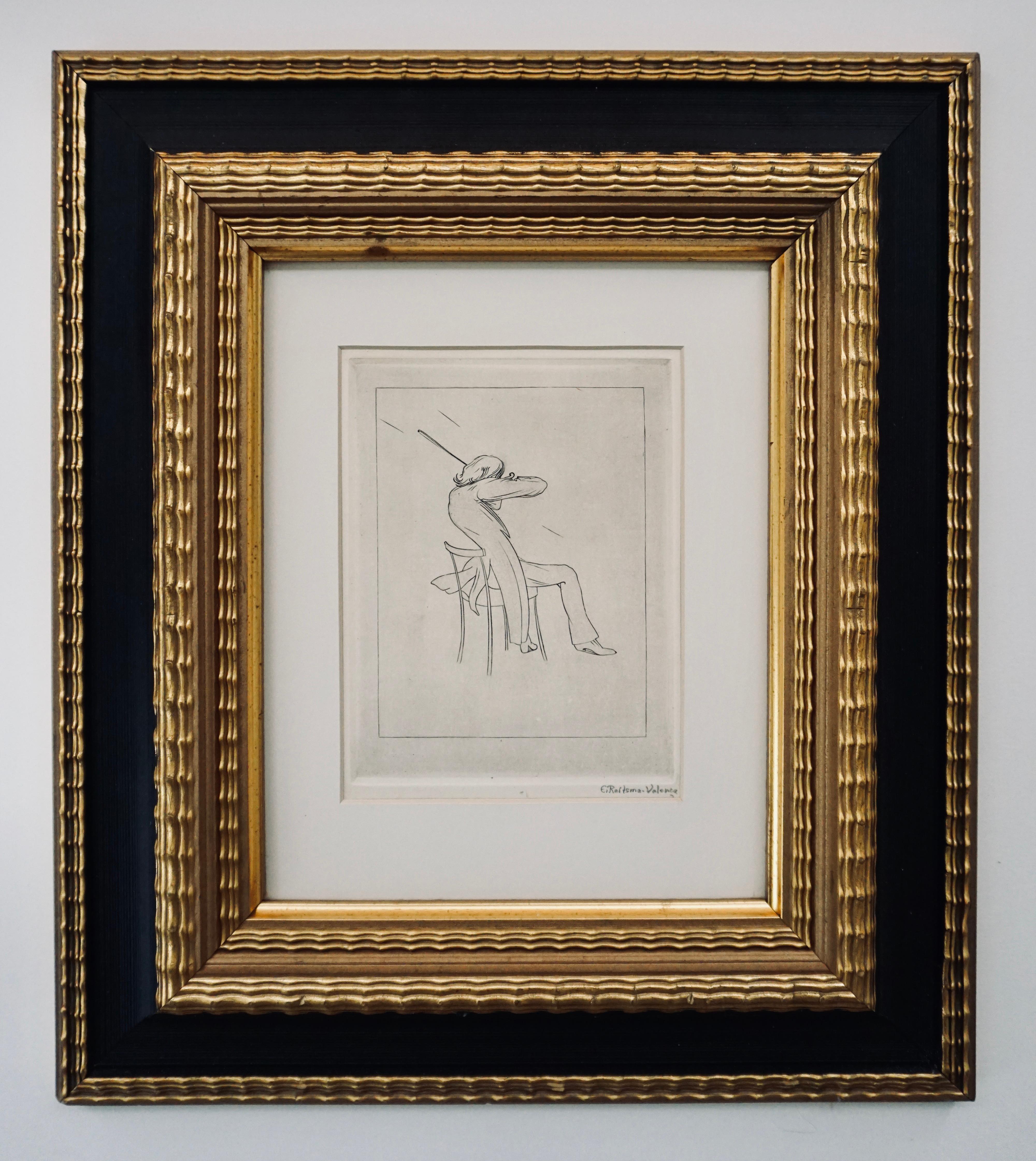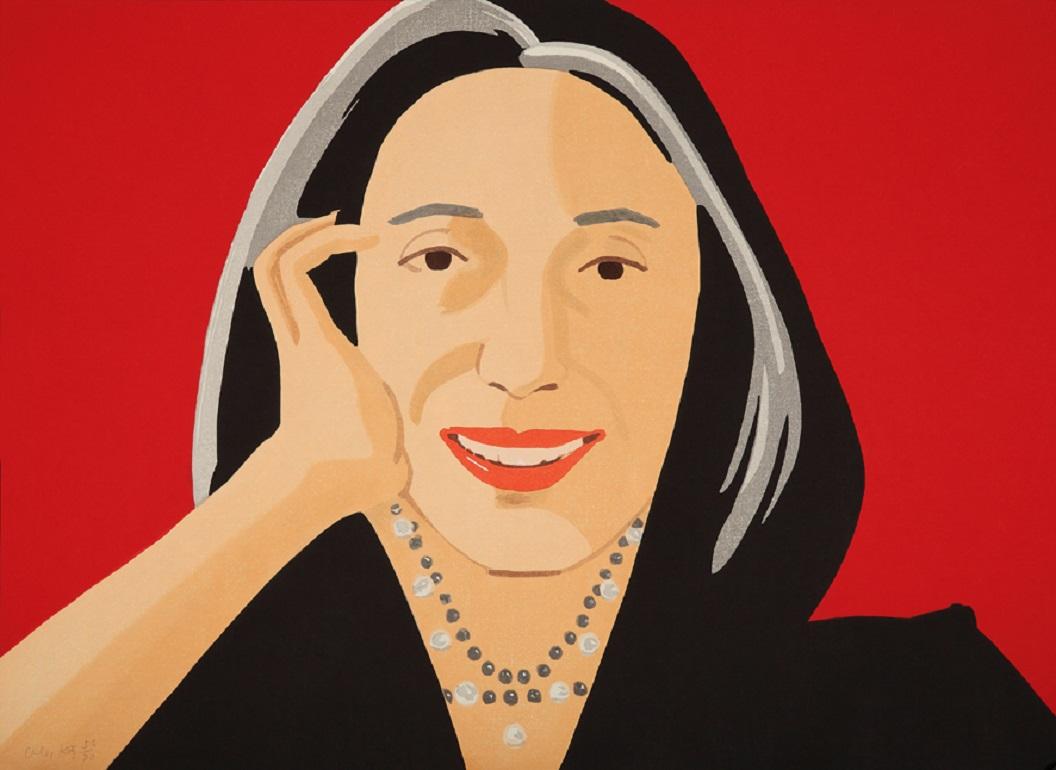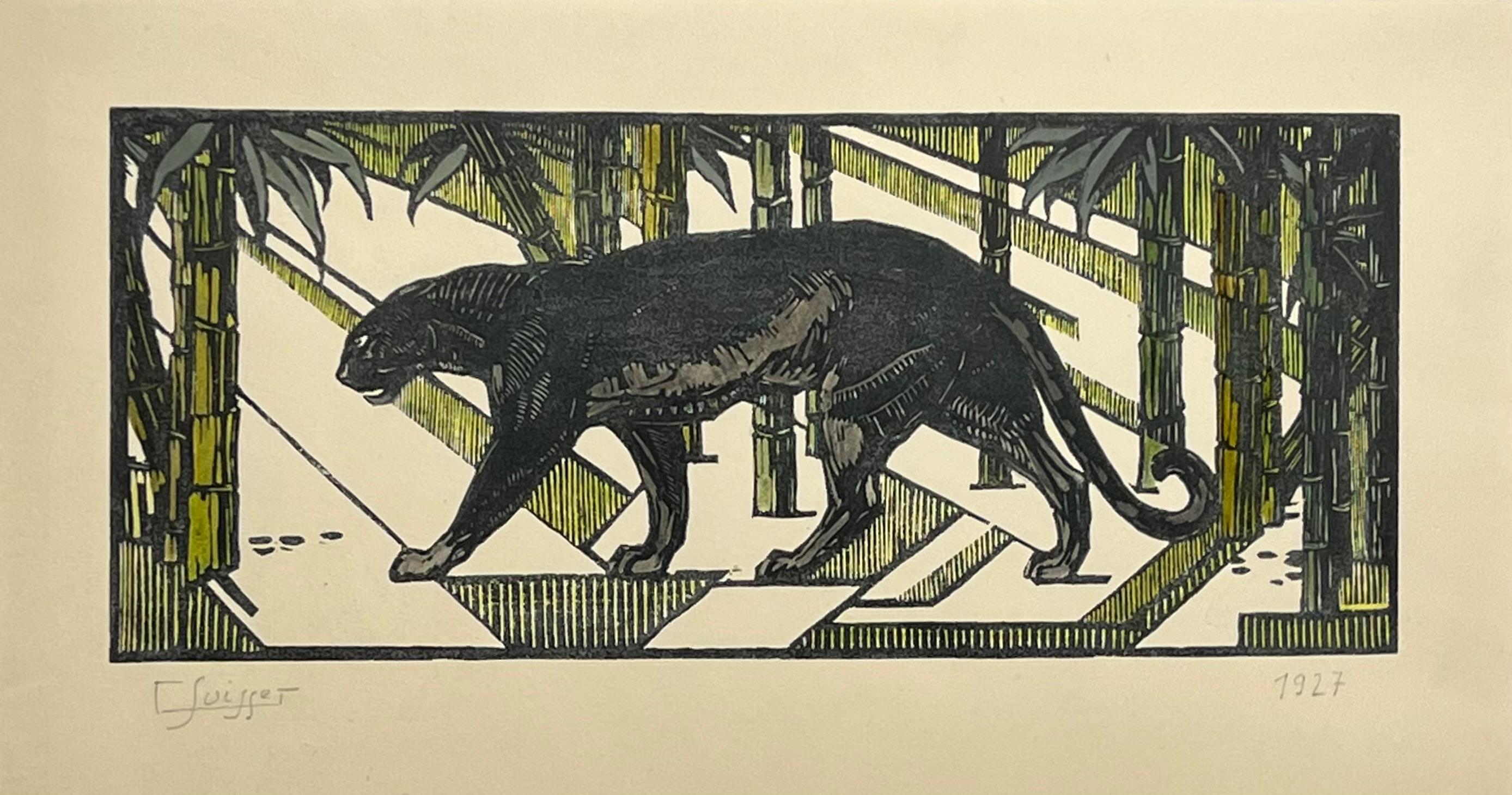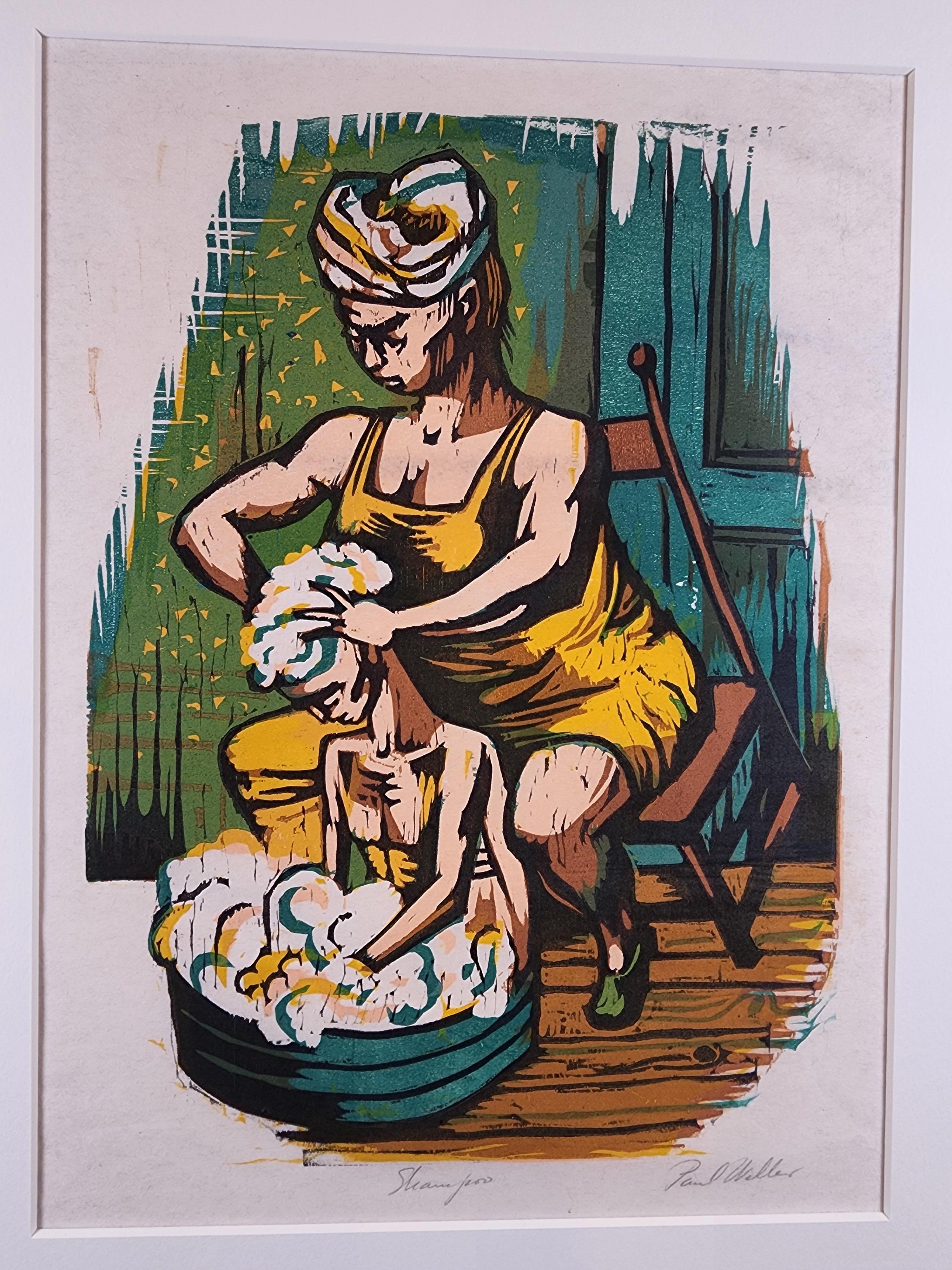Items Similar to April: Otsuyu of Yanagibashi in Wisteria Arbor at Kameido
Want more images or videos?
Request additional images or videos from the seller
1 of 7
Taiso YoshitoshiApril: Otsuyu of Yanagibashi in Wisteria Arbor at Kameido1880
1880
About the Item
April: Otsuyu of Yanagibashi in Wisteria Arbor at Kameido
Color woodcut, 1880
From the series: "Pride of Tokyo's Twelve Months" (Tokyo jiman juni kagetsu)
Signed and sealed lower right (see photo)
Format: Oban
Publisher: Inoue
Engravers: Katata Hori Cho
Very fine impression and color
Built in 1662, Kameido Shrine is still home to the annual Fuji Matsuri or Wisteria Festival, where visitors can enjoy traditional Japanese musical performances.
Reference: Keyes, Series 426, No. 04
Provenance: Kaburagi Kiyokata (1878-1973) noted printmaker and friend of the artist
TAISO YOSHITOSHI
(1839-1892)
Taiso Yoshitoshi was born in the city of Edo (now Tokyo) just before Japan’s violent transformation from a medieval to a modern society. In the mid 19th century pressures from the United States and Europe brought an end to Japan’s two hundred years of self-imposed isolation. In 1868 a pivotal period began known as the Meiji Restoration. It was marked by the return of Imperial power, heightened militarism, a new constitution and industrial advancement, as well as social and political reform. In the midst of shifting values, woodblock print artists like Yoshitoshi struggled to create images that would satisfy the public’s changing tastes.
During the Edo period (1600-1868) woodblock prints, or Ukiyo-e (literally “pictures of the floating world”), became one of the most popular and inexpensive visual art forms in Japan. Published in the cities, visitors bought them as souvenirs and gifts from markets and street peddlers and returned with them to remote villages. From the time the first monochrome prints were published in the 1600s, Ukiyo-e represented a unique collaboration between the publisher, the artists and the public. The rising or diminishing interests of the urban merchant class largely dictated the choice of subject matter in woodblock prints.
Yoshitoshi’s confrontation with the savagery and violence of his times, especially early on in his career, was exorcised through a prolific and bloody series of prints depicting battling warriors, demons and murderers. Later in his career, however, Yoshitoshi’s work took on a distinctive stylistic change. By the 1880s, he was experimenting freely with western concepts of space, perspective and dissonant color combinations. His treatment of movement and facial features reflected a more studied and quiet observation of the human form and emotions. While continuing to choose native themes for his prints, Yoshitoshi’s approach to creating individualized portraits of townspeople, farmers, courtesans and warriors was innovative and groundbreaking. However, by the end of the Meiji Period (1868-1912), the increasing popularity of photography and lithography nearly eclipsed the public’s interest in woodblock prints. Yoshitoshi stood alone as the last great master of Ukiyo-e.
Biography courtesy International Folk Art
- Creator:Taiso Yoshitoshi (1839-1892, Japanese)
- Creation Year:1880
- Dimensions:Height: 13.75 in (34.93 cm)Width: 9.63 in (24.47 cm)
- Medium:
- Period:
- Condition:
- Gallery Location:Fairlawn, OH
- Reference Number:
About the Seller
5.0
Recognized Seller
These prestigious sellers are industry leaders and represent the highest echelon for item quality and design.
Platinum Seller
These expertly vetted sellers are 1stDibs' most experienced sellers and are rated highest by our customers.
Established in 1978
1stDibs seller since 2013
711 sales on 1stDibs
Typical response time: 1 hour
Associations
International Fine Print Dealers Association
- ShippingRetrieving quote...Ships From: Fairlawn, OH
- Return PolicyA return for this item may be initiated within 10 days of delivery.
More From This SellerView All
- No Footprints Show, Where the Flowers Grow DeepBy Shiko MunakataLocated in Fairlawn, OHNo Footprints Show, Where the Flowers Grow Deep Woodcut, 1961 Unsigned (as isssued) From: The "Way" of the Woodcut, three woodcuts, 1961 Publisher: Pratt Adlib Press, Brooklyn, New Y...Category
1960s Modern Figurative Prints
MaterialsWoodcut
- The Child Plants an Oak Tree in the GardenBy Shiko MunakataLocated in Fairlawn, OHThe Child Plants an Oak Tree in the Garden Woodcut, 1961 Unsigned (as issued) From: The "Way" of the Woodcut, three woodcuts, 1961 Publisher: Pratt Adlib Press, Brooklyn, New York,19...Category
1960s Modern Figurative Prints
MaterialsWoodcut
- At New York (Self Portrait)By Shiko MunakataLocated in Fairlawn, OHAt New York (Self Portrait) Woodcut, 1961 Unsigned (as issued) From: The "Way" of the Woodcut, three woodcuts, 1961 Publisher: Pratt Adlib Press, Brooklyn, New York,1961 Printer: Jam...Category
1960s Modern Figurative Prints
MaterialsWoodcut
- Thirsty: The Appearance of a Town Geisha - a So-Called Wine-Server - in the AnseBy Taiso YoshitoshiLocated in Fairlawn, OHThirsty: The Appearance of a Town Geisha - a So-Called Wine-Server - in the Ansei Era Color woodcut, 1888 Signed; Seal: Taiso (see photo) Plate 22 from the series "Thirty-two Aspects...Category
1880s Showa Figurative Prints
MaterialsWoodcut
- PeaceBy Anton RefregierLocated in Fairlawn, OHSigned and titled in pencil Created along with an illustrated book project Song of Peace, 1950-1959. Woodcut printed in orange red ink on Japanese paper Sheet: 16 1/8 x 7"; ...Category
1950s Figurative Prints
MaterialsWoodcut
- Nikki Danjo (Naonon)By Taiso YoshitoshiLocated in Fairlawn, OH"One of the main characters of the kabuki play Meiboku Sendai hagi (The Disputed Succession)" Signed: Ikkaisai Yoshitoshi ga (in gourd shaped cartouche) Format: oban Publisher: Da...Category
1860s Figurative Prints
MaterialsWoodcut
You May Also Like
- Le Vieux Manuscrits, Coree-SeoulBy Paul JacouletLocated in Rio Vista, CAFascinating artwork titled Le Vieux manusrits (old writings Seoul Korea) by Paul Jacoulet. (French-Japanese 1896-1960) finely crafted with lovely graduating background color blue to light green. Depicts a figure seated on a pink pillow wearing a Korean hat...Category
20th Century Realist Figurative Prints
MaterialsWoodcut
- ViolinistLocated in Berlin, MDEngelina (Engelien) Reitsma-Valença (3 May 1889 - 11 July 1981) Amsterdam, Netherland. The portrait is of a violinist playing what appears to be an enervating piece. An engraver, st...Category
Early 20th Century Art Deco Figurative Prints
MaterialsWoodcut
- Ada - Portrait Print by Alex Katz, Ada, Red, Pearl Necklace, Portrait, Pop ArtBy Alex KatzLocated in Köln, DE"Ada" from 2011 is a Japanese woodblock in thirty-one colors on New Hosho paper. We are offering the number 18/70. 3 Artist's proofs. Ada is Alex Katz' wife and his most important mu...Category
2010s Pop Art Figurative Prints
MaterialsWoodcut
- Art deco handcolored woodcut on paper - Walking black panther by Gaston SuisseLocated in Carouge GE, GEGaston Suisse (1896-1988) Panthère noire dans les bambous, 1927 Gravure sur bois, sur papier Velin de Van Gelder. Rehaussé aux lavis d’encre de Chine par l’artiste Signé en bas à gauche et daté 1927 en bas à droite Black panther in a forest of bamboos, 1927 A handcolored woodcut on Velin de Van Gelder paper Signed and dated 1927 Bibliographie /Literature Gaston Suisse, splendeur du laque art déco. Emmanuel Bréon. Somogy Éditions d'art, Paris 2013, reproduite page 105 (un autre exemplaire reproduit) The artist made a wood engraving of which he made about twenty prints himself. These proofs were not marketed as is, Gaston Suisse reworked each of the proofs using Indian ink washes in order to obtain different effects for each proof, which are thus unique original works. Born in 1896 in a family of artists, his father Georges was a close friend of Siegfried Bing and a great lover of Japanese art and a bibliophile. He passed his taste for art to his son whom he often took to draw at the Botanic Garden . Around 1910, Gaston Suisse, who hasn't entered yet the artistic school, met Paul Jouve, then 18 years his elder, who was already famous. In 1911, at the age of 17, he entered the National School of Decorative Art where he followed the teachings of Paul Renouard. Thanks to his knowledge and taste for the Japanese art, he chose lacquer painting as his specialty. His practice of this noble and demanding subject were so much appreciated that he was awarded with two gold medals in 1913 and 1914. Mobilized during the war , he joined the army and go in Salonika where he found his friend Jouve. In 1918, he finished his studies at the School of Applied Arts in order to perfect his training. He learned in particular the techniques of gilding and oxidation of metals. The first productions of Gaston Suisse, furniture and objects in lacquer with geometrical patterns, were an instant success and Suisse was appointed as member of Salon d'Automne in 1924, the very year of his first exhibition. Considered as an artist-decorator, his sincere and deep friendship with Jouve linked him in parallel with the groups of the animaliers of the Jardin des Plantes and became a close friend of Edouard-Marcel Sandoz. When travelling to Maghreb and Middle-East between 1923 and 1925, he produced numerous drawings representing antelopes, apes and fennec foxes...Category
1920s Art Deco Animal Prints
MaterialsIndia Ink, Woodcut
- In the Floating World - Portfolio of 16By Yoshitomo NaraLocated in Tokyo, 13LOT:20221109N01 Reworked woodcut, Fuji Xerox copy Each signed, dated and numbered Each edition 9 of 50 Each 41.5 x 29.5 cm Publisher: Tomio Koyama Gallery, Tokyo Provenance: Phillips Auction...Category
1990s Figurative Prints
MaterialsWoodcut
- ShampooLocated in Raleigh, NCRgrFineArts is pleased to offer this New York WPA color woodcut by Paul Weller titled Shampoo. The WPA label is affixed to the margin on the reverse of the print.Category
1940s American Realist Figurative Prints
MaterialsWoodcut
Recently Viewed
View AllMore Ways To Browse
Art Forms In Antique
Antique Industrial Other
Warrior Prints
1880s Art Print
Antique Style Photography
Warriors Battles
Woodblock Print European
Woodblock Portrait
Antique Japanese Folk Art
Edo Period Woodblock
April Key
Japanese Woodblock Portrait
Farmers Market
Japanese Farmer
Antique Demon
Meiji Woodblock
Wisteria Art
Native Warrior





